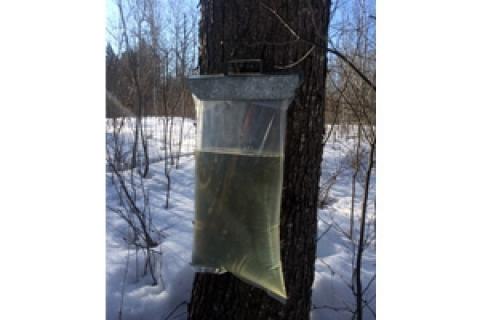
As the thermometer starts to reach the 40s consistently, the only other thought going through my mind other than fishing is that of tapping trees. Maple syrup is a family tradition in most households in northern Wisconsin and the process of tapping maple trees, collecting the sap and making your own syrup is really quite simple. Here's what you need to know about when to tap, what trees to tap, and how to tap for maple syrup.
When to Tap Trees for Maple Syrup
 |
| Holes should be tapped 2-3 feet off the ground to allow you to easily remove buckets or bags of sap. |
In northern Wisconsin, tapping season normally starts between mid-March and early April. The exact time of year depends on when the conditions become just right (daytime temperatures above freezing and nighttime temperatures below freezing). This freeze thaw cycle transfers the sap from the tree to the roots. Ideally sap flows anywhere between 4 to 6 weeks but can be much shorter if the conditions get too warm too fast.
What Trees to Tap for the Best Maple Syrup
The best trees to tap are Sugar, Black and Red Maples. When picking your trees to tap, look for trees that are mature and measure at least 12 inches around. In addition to this judge each tree that you plan on tapping for its health. You want trees that are generally healthy and damage free. If you drill into a tree to set a tap and the inner bark is considerable discolored try drilling another spot or finding another tree. If you only have a few mature trees on your property then tapping a tree multiple times might get you the sap that you need. In general you can tap a tree two or three times, depending upon its size. If a tree is 12-20 inches then it can support a single tap. If it is between 21-30 inches then it can support two taps and anything larger than 30 inches can support three taps.
The Maple Syrup Tapping Process
When you start the actual tapping process the height of the tap hole should be 2-3 feet off the ground. At this height it will be convenient for you to remove buckets or bags of sap. Keep in mind that as you start the sapping process there might be a few feet of snow on the ground and this will melt sooner or later changing the height of your taps. As you drill the tree (7/16 drill bit) do so with a slight upward angle so that as the sap runs it will hit the spile and flow downhill into the bucket. Spiles only need to be tapped into the tree 1 1/2 to 2 inches. Be careful when pounding the spile into the trees to avoid cracking or splitting the tree around the spile. This will cause the sap to run around your spile and lessen what you collect. If the tree has been tapped before, try not to tap within 6 inches of an old hole. Ideally, try and place the tap hole on the south side of the tree and above a large root or below a large branch.
After tapping the trees, the hard work starts with collecting the sap, boiling the sap to evaporate off the water, and finally finishing the sap to produce syrup. To me, maple syruping is another excuse to spend more time outside during the spring when the weather in northern Wisconsin is often not the best. The result of the hard work is syrup that can be enjoyed for the rest of the year.
To learn more about making maple syrup, see Harvesting Your Own Maple Syrup.
- 6777 views

